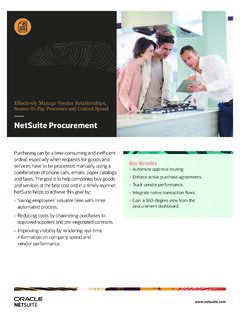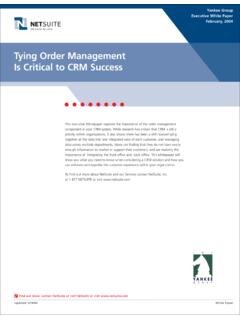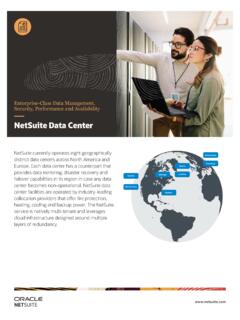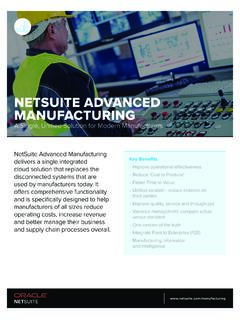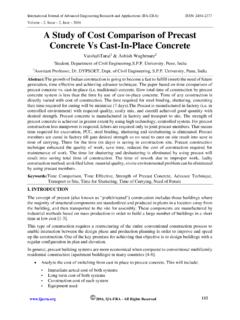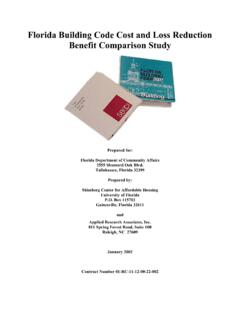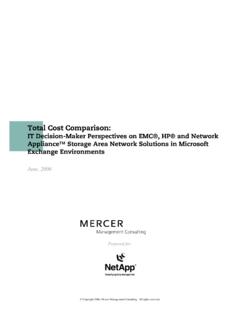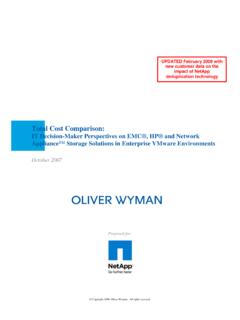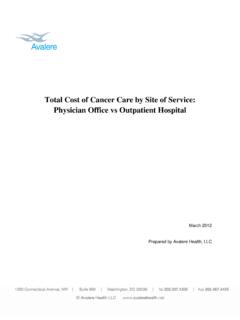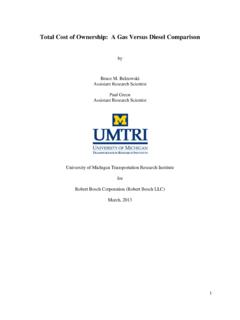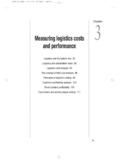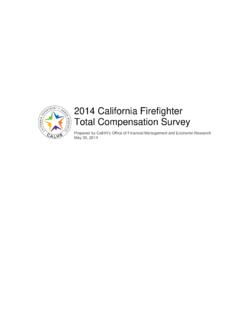Transcription of The Compelling TCO Case for Cloud Computing in SMB and …
1 The Compelling TCO case for Cloud Computing in SMB and Mid-Market EnterprisesA 4-year total cost of ownership (TCO) perspective comparing Cloud and on-premise business application deploymentA H u rw i t z wH i t e PA Pe r Sanjeev Aggarwal, Partner Laurie McCabe, PartnerStudy sponsored by NetSuiteHurwitz white Paper ContentsExecutive 2 Figure 1. Four-Year total Ownership cost Distribution - NetSuite and Microsoft Dynamics GP and 2 Section 1: SMB & Mid-Market Enterprises Face Difficult Business and Economic Challenges.
2 3 Section 2: Cloud Computing Shifts the TCO 4 Figure 2. Key Benefits of Cloud -based Business Application 4 Section 3: Why does TCO matter?.. 5 Section 4: What does this TCO model include?.. 6 Section 5: Assumptions for Developing the TCO 7 Section 6: TCO 8 Figure 3. Key Functions and Features for Mid-Market 9 Section 7: TCO Comparison for Cloud vs. On-premise Business 9 Figure 4. 100-User TCO for NetSuite and Microsoft Dynamics 10 Figure 5. TCO Comparison for 52-users, 100-user, 200-user for NetSuite and Microsoft Dynamics 12 Section 8: Recommendations for SMB and Mid-Market 13 Section 9: 15the Compelling tCO case for Cloud Computing in SMB and Mid-Market enterprises Hurwitz white Paper Executive SummaryCloud Computing essentially eliminates the need for customers to buy, deploy and maintain IT infrastructure or application software individually.
3 Regardless of the application, the Cloud Computing vendor takes responsibility for all of the infrastructure required to run the solution--servers, backup, software, operating systems, databases, updates, migration, power and cooling, facility space, etc., and associated internal and third-party staffing costs. Because Cloud Computing vendors manage all of their customers on a single instance of the software, they can amortize costs over thousands of customers. This yields substantial economies of scale and skill, and lowers total cost of ownership (TCO).Key findings from our analysis include: Overall TCO for NetSuite s Cloud -based integrated solution suite is significantly lower than a comparable on-premise solution consisting of Microsoft Dynamics GP and CRM.
4 This holds true for both SMB and mid-market firms. The TCO for Cloud -based vs. on-premise business application solutions was: 55% lower for 52 users 50% lower for 100 users 35% lower for 200 users IT Infrastructure costs (hardware, software and on-going maintenance required to run the on-premise business applications) account for about 11% of the total cost of deploying on-premise business applications almost $172,500 in the 100 user scenario (Figure 1). Comparably, there are no IT Infrastructure related costs for Cloud -based business solutions. total cost for Cloud Computing is a full $730,745 less than on-premise for the 100 user scenario.
5 With Cloud Computing , the overall cost of running the solution is more predictable than on-premise. Figure 1 shows that application subscription costs accounted for 65% of the total solution cost , whereas the on-premise license cost only accounted for 26% of total cost . Spending for application implementation and support (including internal IT staff and/or VAR, consultant or SI resources) is significantly higher for on-premise solutions than for Cloud -based solutions, as much as times more for the 100 user scenario. Pre-integrated front and back office functionality in the NetSuite offering incrementally contributes to reducing integration complexity and lowers application implementation Compelling tCO case for Cloud Computing in SMB and Mid-Market enterprisesFigure 1.
6 Four-Year total Ownership cost Distribution - NetSuite and Microsoft Dynamics GP and CRMS ource: Hurwitz & AssociatesIntroductionSmall and medium businesses (SMBs) face a tricky dilemma in today s challenging economic climate. It s no longer business as usual; companies need to figure out how to optimize for today, and get on track to capitalize on new opportunities that will emerge as the economy starts to grow again. They need business solutions to help them to manage more efficiently day-to-day, and also provide them with the intelligence they need to move the business SMBs evaluate different business application options, total cost of ownership (TCO) is often top of mind.
7 Many customers have become interested in how Cloud Computing or software-as-a-service (SaaS) can help lower their costs by eliminating upfront capital investments and ongoing maintenance costs associated with on-premise this study, we begin with a brief overview of SMB requirements and challenges, and provide context on how Cloud Computing is reshaping the economics and TCO of the business applications landscape. Then, we examine and compare the total cost of ownership for planning and design, infrastructure hardware, software and support, application software, deployment and training costs of Microsoft s Dynamics GP and CRM traditional on-premise solutions, with those of NetSuite, which provides an integrated front and back office SaaS solution.
8 We conclude with our recommendations for SMB customers evaluating these alternative Computing white Paper 2the Compelling tCO case for Cloud Computing in SMB and Mid-Market enterprisesOverall TCO for NetSuite s Cloud -based integrated solution suite is significantly lower than a comparable on-premise solution consisting of Microsoft Dynamics GP and white Paper Section 1: SMB & Mid-Market Enterprises Face Difficult Business and Economic Challenges Just like larger enterprises, SMBs and mid-market enterprises need business solutions that help them to manage day-to-day operations and processes more efficiently.
9 At the same time, they want insight and intelligence to successfully adapt to fluid business environment, and ensure compliance with regulatory requirements. However, SMBs have smaller budgets and fewer IT staff than larger companies. Small businesses of 50 to 100 employees may have only one full-time person typically an IT generalist to support a complex array of IT resources and users. In medium businesses (100 to 999 employees), IT staffing grows, averaging about one full-time IT person for every 100 employees. But, business and IT complexity often outstrip the growth of IT resources, especially in mid-market firms, who face the complexities of managing several locations, multiple servers, an expanding array of desktops and devices, and a more mobile workforce.
10 As a result, reacting to daily application availability, maintenance and support issues can max out the IT staff, leaving little time to deploy new solutions or even to update existing ones. The difficult economic climate only heightens SMB requirements for easier to use, faster to deploy and more functional solutions to help the business effectively navigate through uncertainty and improve the bottom Compelling tCO case for Cloud Computing in SMB and Mid-Market enterprisesBusiness and IT complexity often outstrip the growth of IT resources,especially in mid-market Easing the upgrade process and improving operations When a new CEO came on board at this 50-person insurance rating, quoting and policy solutions in 2000.
